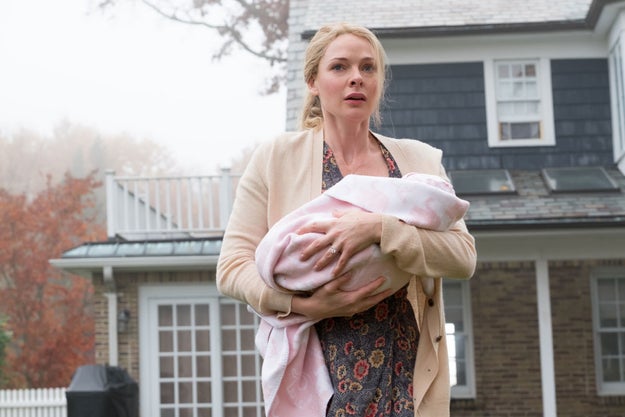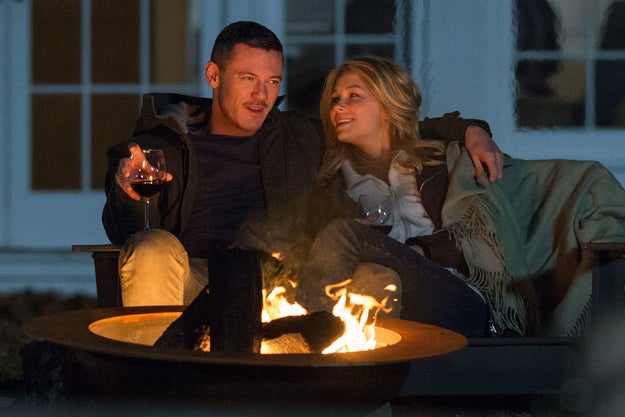
The Girl on the Train is centered on the hamlet surrounding the Ardsley-on-Hudson station, a white picket blur of domestic anxiety. The village is perched prettily on the edge of the river and handily on New York’s Metro-North railway line. It’s the kind of community where residents are able to keep their city jobs without doing city living — good schools, houses with yards, easy commutes, an old-school oasis of upper middle classdom that, for each of the movie’s three female leads, becomes layered with a different sort of dread.
For Megan (Haley Bennett), Ardsley-on-Hudson is a “baby factory” to which she’s been consigned against her wishes by her husband Scott (Luke Evans), who hopes a job as a nanny will finally lead her to wanting a family of their own. She prowls restlessly along her back porch like a caged lynx and fills in the rest of her time with pilates and therapy.
For Anna (Rebecca Ferguson), it’s an all-organic-Pinterest-perfect mold into which she has to fit herself. But the new mom worries she’s part of a repeating pattern for her spouse, who bumped her up from “other woman” to wife.
And for Rachel Watson (Emily Blunt), it’s a fuzzily-remembered paradise from which she’s been cast out for being a destructive drunk struggling to come to terms with the fact that she can’t conceive.
Two years after her divorce from Tom (Justin Theroux), the alcoholic, broken-hearted, thirtysomething “girl” of the title is still clinging to the ruins of her marriage, calling her ex, crashing in a friend’s spare room, and taking the train into the city each day to preserve the pretense that she wasn’t fired from her job months ago. When Rachel passes Ardsley-on-Hudson, she presses herself against the window in order to look into the house shared by Megan and Scott, about whom she’s concocted wistful fantasies of homey joy based only on passing glances. She tries and fails to not look at the place a few doors down that was hers before Tom left her for Anna — fresher, less damaged, more fertile.
Rebecca Ferguson in The Girl on the Train. Barry Wetcher / Universal Pictures
The Girl on the Train is an adaptation of Paula Hawkins’ best-selling novel, directed by Tate Taylor, a man responsible for the feature-length facepalm that is The Help and the weirdly great James Brown biopic Get on Up. But The Girl on the Train is not weirdly great, or even good, though it doesn’t really aim to be, positioning itself unabashedly as a knock-off Gone Girl, around to mop up fans looking for more by the way of a missing woman (Megan), an unreliable narrator (the blackout-prone Rachel), and scandal-tinged tragedy erupting in a small town. Where Gone Girl crackled with nastiness, The Girl on the Train manages, at its best, a low murmur.
As a Hitchcockian thriller in which Rachel struggles through alcohol-muddled memories in an attempt to find out if she witnessed or was maybe even responsible for Megan’s disappearance, The Girl on the Train is unbearably slack. It indulges in a long, languid setup before setting its story into motion; but once it does, possible leads — Scott is revealed to be controlling and emotionally abusive, Megan’s shrink (Édgar Ramírez) may have been sleeping with his patient, and Rachel turns out to indulge in some vividly homicidal fantasies — bubble up without urgency. Even the climactic reveal is short on fire, like a afternoon klatch everyone’s perturbed to find turning bloody.
And yet, there’s something hard to shake about The Girl on the Train’s dark fantasia of damaging internalized feminine expectations, traces of which linger long after the plot has made its last twist. There’s a villain here, but that’s much less interesting than the characters’ self-inflicted misery, which stems from feelings of inadequacy, from failure for not living up to phantom standards of being a wife and a mother, from not wanting to, or from being willing to make bleak compromises within to maintain that perfect exterior.
Luke Evans and Haley Bennett in The Girl on the Train. Barry Wetcher / Universal Pictures
As Tom, Theroux does little to sell himself as the object of multiple characters’ desires and desperation. He’s central, but at the same time, he’s a trench-and-tie wearing blank, the handsome provider arriving home at the end of the workday to the family he’s tucked away in Westchester. He’s the embodiment of a goal each of the three women have accepted as a pursuit — the home in the country, shopping at the farmers market, cuddling in front of the firepit at night, the eventual baby — only to find it’s not guaranteed to amount to a happy ending, no matter how nice it looks from outside.
So ingrained are these images that, more often than not, it’s the women who end up policing each other in The Girl on the Train’s scenically oppressive exurban community. Megan gets glares from other wives in town for being too ripe, not adequately matronly. Anna, a stay-at-home mom who employs Megan as a nanny seemingly to get a little space and avoid being alone at home with the baby all day, snaps defensively that “there’s no job more important than raising a child.” And Rachel rattles between self-loathing and rage, castigating herself for her all perceived failings, infertility among them, then giving into monologues about bashing Anna’s head in.
Blunt, doing work that’s considerably better than the movie she’s starring in, turns her character into an unforgettably sodden mess who treats herself like someone who has no worth out outside of her marriage, trapped in a disastrous cycle of drunken outbursts, regret, and drinking more to forget. She stares and stares at Ardsley-on-Hudson from behind the glass of the window, trying to wish herself back, imagining others basking in a bliss that’s actually a mirage. But she’d do better to ride that train somewhere far away.



